Assessment Criteria for BSBWRK510: Manage Employee Relations - Details
VerifiedAdded on 2021/02/21
|53
|10088
|30
Homework Assignment
AI Summary
This document outlines the assessment criteria for the BSBWRK510 unit, focusing on managing employee relations. It details the elements of competency, including developing and implementing employee relations policies, managing negotiations, and resolving conflicts. The document specifies performance evidence required, such as analyzing organizational documentation, developing plans, and managing conflicts, alongside the necessary foundation skills like reading, writing, and oral communication. Furthermore, it defines the assessment conditions, tools, and processes, including learner workbook activities, observations, major activities, skills and knowledge activities, case studies, and learner guides. The observation checklist provides a structured framework for assessing practical tasks related to employee relations management, ensuring learners can demonstrate their skills in developing policies, implementing plans, and managing negotiations. The document emphasizes the importance of practical demonstrations and observations in assessing competency, providing clear guidelines for instructors and learners.
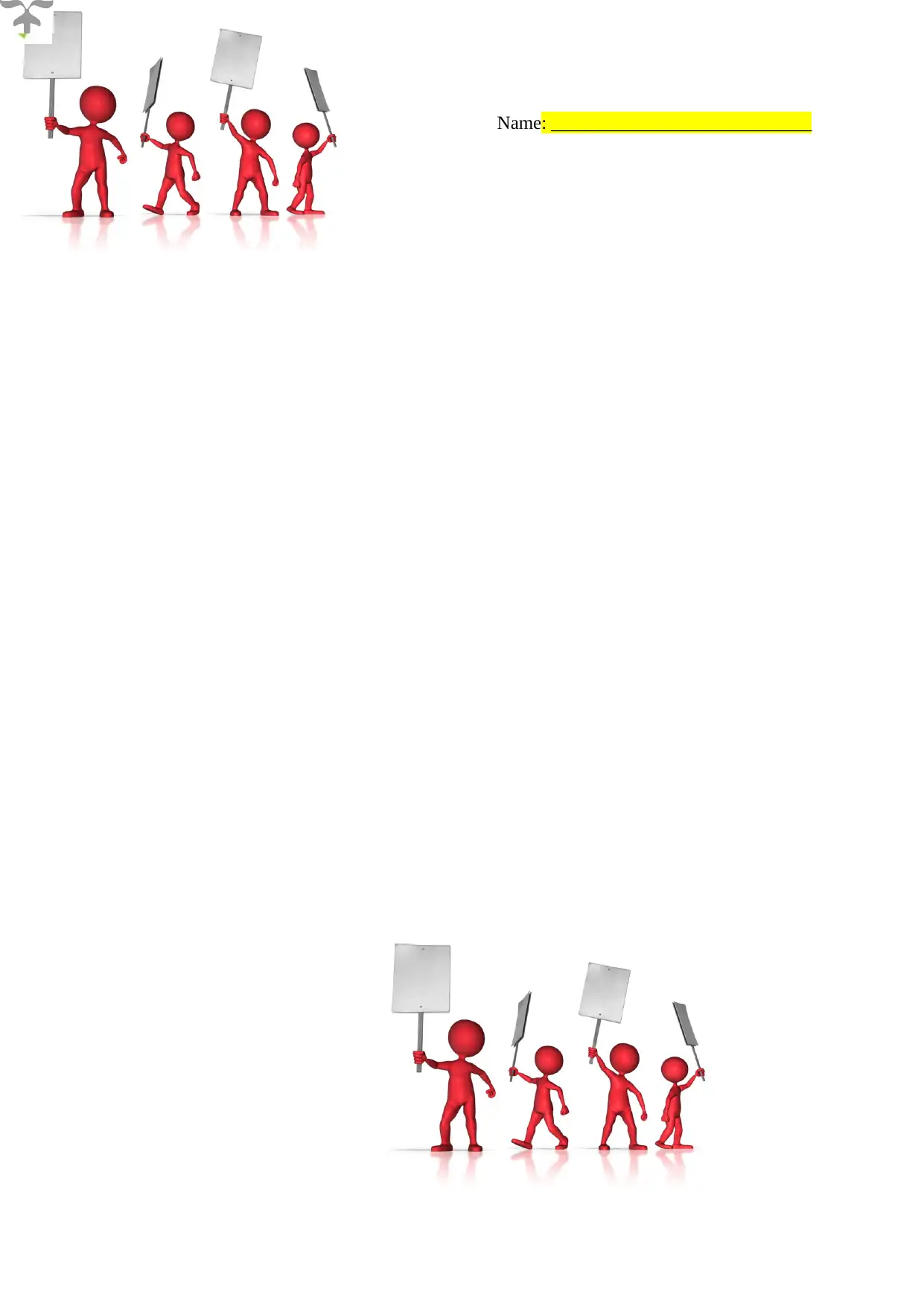
Name: ____________________________
Paraphrase This Document
Need a fresh take? Get an instant paraphrase of this document with our AI Paraphraser

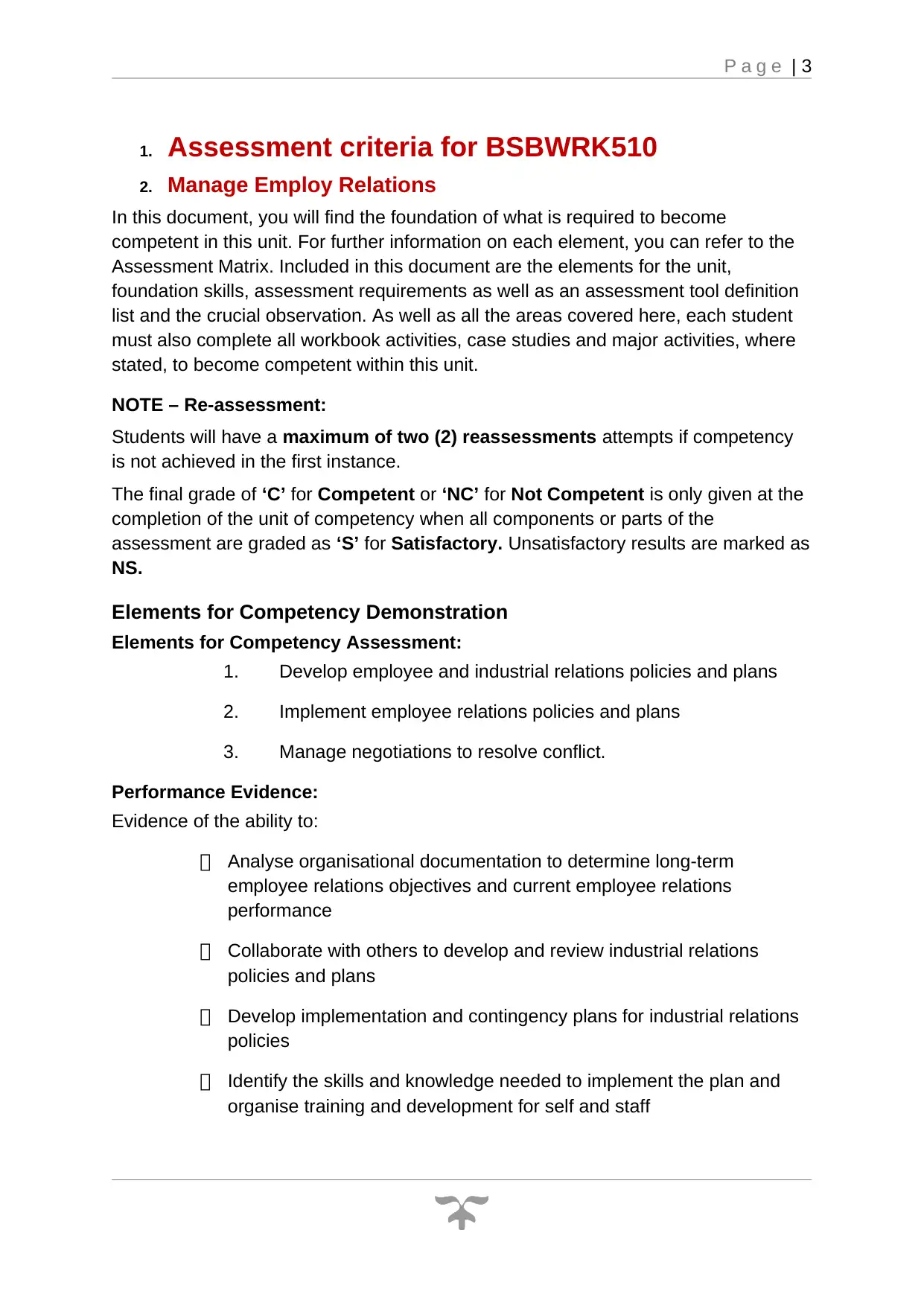
P a g e | 3
1. Assessment criteria for BSBWRK510
2. Manage Employ Relations
In this document, you will find the foundation of what is required to become
competent in this unit. For further information on each element, you can refer to the
Assessment Matrix. Included in this document are the elements for the unit,
foundation skills, assessment requirements as well as an assessment tool definition
list and the crucial observation. As well as all the areas covered here, each student
must also complete all workbook activities, case studies and major activities, where
stated, to become competent within this unit.
NOTE – Re-assessment:
Students will have a maximum of two (2) reassessments attempts if competency
is not achieved in the first instance.
The final grade of ‘C’ for Competent or ‘NC’ for Not Competent is only given at the
completion of the unit of competency when all components or parts of the
assessment are graded as ‘S’ for Satisfactory. Unsatisfactory results are marked as
NS.
Elements for Competency Demonstration
Elements for Competency Assessment:
1. Develop employee and industrial relations policies and plans
2. Implement employee relations policies and plans
3. Manage negotiations to resolve conflict.
Performance Evidence:
Evidence of the ability to:
Analyse organisational documentation to determine long-term
employee relations objectives and current employee relations
performance
Collaborate with others to develop and review industrial relations
policies and plans
Develop implementation and contingency plans for industrial relations
policies
Identify the skills and knowledge needed to implement the plan and
organise training and development for self and staff
1. Assessment criteria for BSBWRK510
2. Manage Employ Relations
In this document, you will find the foundation of what is required to become
competent in this unit. For further information on each element, you can refer to the
Assessment Matrix. Included in this document are the elements for the unit,
foundation skills, assessment requirements as well as an assessment tool definition
list and the crucial observation. As well as all the areas covered here, each student
must also complete all workbook activities, case studies and major activities, where
stated, to become competent within this unit.
NOTE – Re-assessment:
Students will have a maximum of two (2) reassessments attempts if competency
is not achieved in the first instance.
The final grade of ‘C’ for Competent or ‘NC’ for Not Competent is only given at the
completion of the unit of competency when all components or parts of the
assessment are graded as ‘S’ for Satisfactory. Unsatisfactory results are marked as
NS.
Elements for Competency Demonstration
Elements for Competency Assessment:
1. Develop employee and industrial relations policies and plans
2. Implement employee relations policies and plans
3. Manage negotiations to resolve conflict.
Performance Evidence:
Evidence of the ability to:
Analyse organisational documentation to determine long-term
employee relations objectives and current employee relations
performance
Collaborate with others to develop and review industrial relations
policies and plans
Develop implementation and contingency plans for industrial relations
policies
Identify the skills and knowledge needed to implement the plan and
organise training and development for self and staff
⊘ This is a preview!⊘
Do you want full access?
Subscribe today to unlock all pages.

Trusted by 1+ million students worldwide
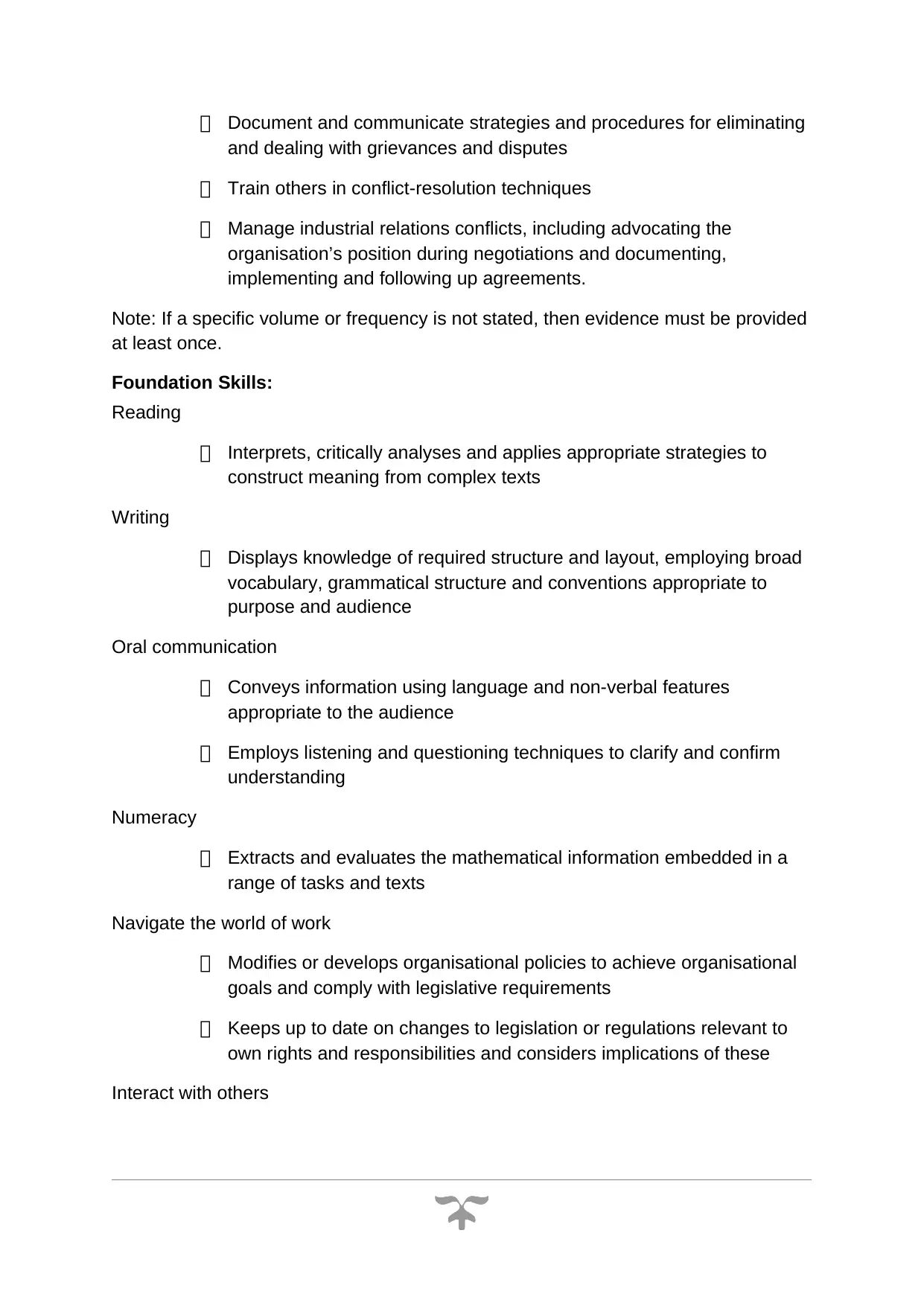
Document and communicate strategies and procedures for eliminating
and dealing with grievances and disputes
Train others in conflict-resolution techniques
Manage industrial relations conflicts, including advocating the
organisation’s position during negotiations and documenting,
implementing and following up agreements.
Note: If a specific volume or frequency is not stated, then evidence must be provided
at least once.
Foundation Skills:
Reading
Interprets, critically analyses and applies appropriate strategies to
construct meaning from complex texts
Writing
Displays knowledge of required structure and layout, employing broad
vocabulary, grammatical structure and conventions appropriate to
purpose and audience
Oral communication
Conveys information using language and non-verbal features
appropriate to the audience
Employs listening and questioning techniques to clarify and confirm
understanding
Numeracy
Extracts and evaluates the mathematical information embedded in a
range of tasks and texts
Navigate the world of work
Modifies or develops organisational policies to achieve organisational
goals and comply with legislative requirements
Keeps up to date on changes to legislation or regulations relevant to
own rights and responsibilities and considers implications of these
Interact with others
and dealing with grievances and disputes
Train others in conflict-resolution techniques
Manage industrial relations conflicts, including advocating the
organisation’s position during negotiations and documenting,
implementing and following up agreements.
Note: If a specific volume or frequency is not stated, then evidence must be provided
at least once.
Foundation Skills:
Reading
Interprets, critically analyses and applies appropriate strategies to
construct meaning from complex texts
Writing
Displays knowledge of required structure and layout, employing broad
vocabulary, grammatical structure and conventions appropriate to
purpose and audience
Oral communication
Conveys information using language and non-verbal features
appropriate to the audience
Employs listening and questioning techniques to clarify and confirm
understanding
Numeracy
Extracts and evaluates the mathematical information embedded in a
range of tasks and texts
Navigate the world of work
Modifies or develops organisational policies to achieve organisational
goals and comply with legislative requirements
Keeps up to date on changes to legislation or regulations relevant to
own rights and responsibilities and considers implications of these
Interact with others
Paraphrase This Document
Need a fresh take? Get an instant paraphrase of this document with our AI Paraphraser
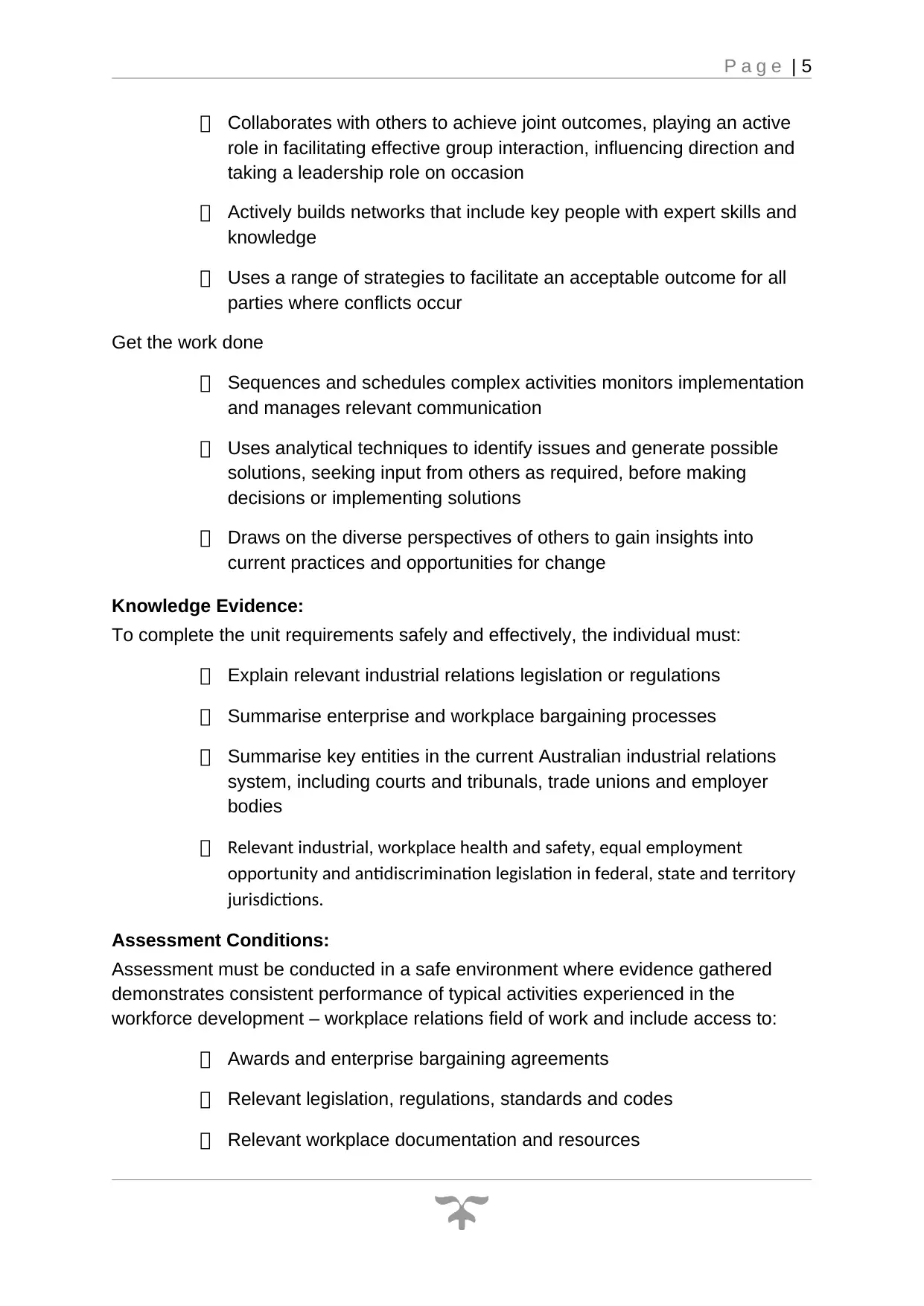
P a g e | 5
Collaborates with others to achieve joint outcomes, playing an active
role in facilitating effective group interaction, influencing direction and
taking a leadership role on occasion
Actively builds networks that include key people with expert skills and
knowledge
Uses a range of strategies to facilitate an acceptable outcome for all
parties where conflicts occur
Get the work done
Sequences and schedules complex activities monitors implementation
and manages relevant communication
Uses analytical techniques to identify issues and generate possible
solutions, seeking input from others as required, before making
decisions or implementing solutions
Draws on the diverse perspectives of others to gain insights into
current practices and opportunities for change
Knowledge Evidence:
To complete the unit requirements safely and effectively, the individual must:
Explain relevant industrial relations legislation or regulations
Summarise enterprise and workplace bargaining processes
Summarise key entities in the current Australian industrial relations
system, including courts and tribunals, trade unions and employer
bodies
Relevant industrial, workplace health and safety, equal employment
opportunity and antidiscrimination legislation in federal, state and territory
jurisdictions.
Assessment Conditions:
Assessment must be conducted in a safe environment where evidence gathered
demonstrates consistent performance of typical activities experienced in the
workforce development – workplace relations field of work and include access to:
Awards and enterprise bargaining agreements
Relevant legislation, regulations, standards and codes
Relevant workplace documentation and resources
Collaborates with others to achieve joint outcomes, playing an active
role in facilitating effective group interaction, influencing direction and
taking a leadership role on occasion
Actively builds networks that include key people with expert skills and
knowledge
Uses a range of strategies to facilitate an acceptable outcome for all
parties where conflicts occur
Get the work done
Sequences and schedules complex activities monitors implementation
and manages relevant communication
Uses analytical techniques to identify issues and generate possible
solutions, seeking input from others as required, before making
decisions or implementing solutions
Draws on the diverse perspectives of others to gain insights into
current practices and opportunities for change
Knowledge Evidence:
To complete the unit requirements safely and effectively, the individual must:
Explain relevant industrial relations legislation or regulations
Summarise enterprise and workplace bargaining processes
Summarise key entities in the current Australian industrial relations
system, including courts and tribunals, trade unions and employer
bodies
Relevant industrial, workplace health and safety, equal employment
opportunity and antidiscrimination legislation in federal, state and territory
jurisdictions.
Assessment Conditions:
Assessment must be conducted in a safe environment where evidence gathered
demonstrates consistent performance of typical activities experienced in the
workforce development – workplace relations field of work and include access to:
Awards and enterprise bargaining agreements
Relevant legislation, regulations, standards and codes
Relevant workplace documentation and resources
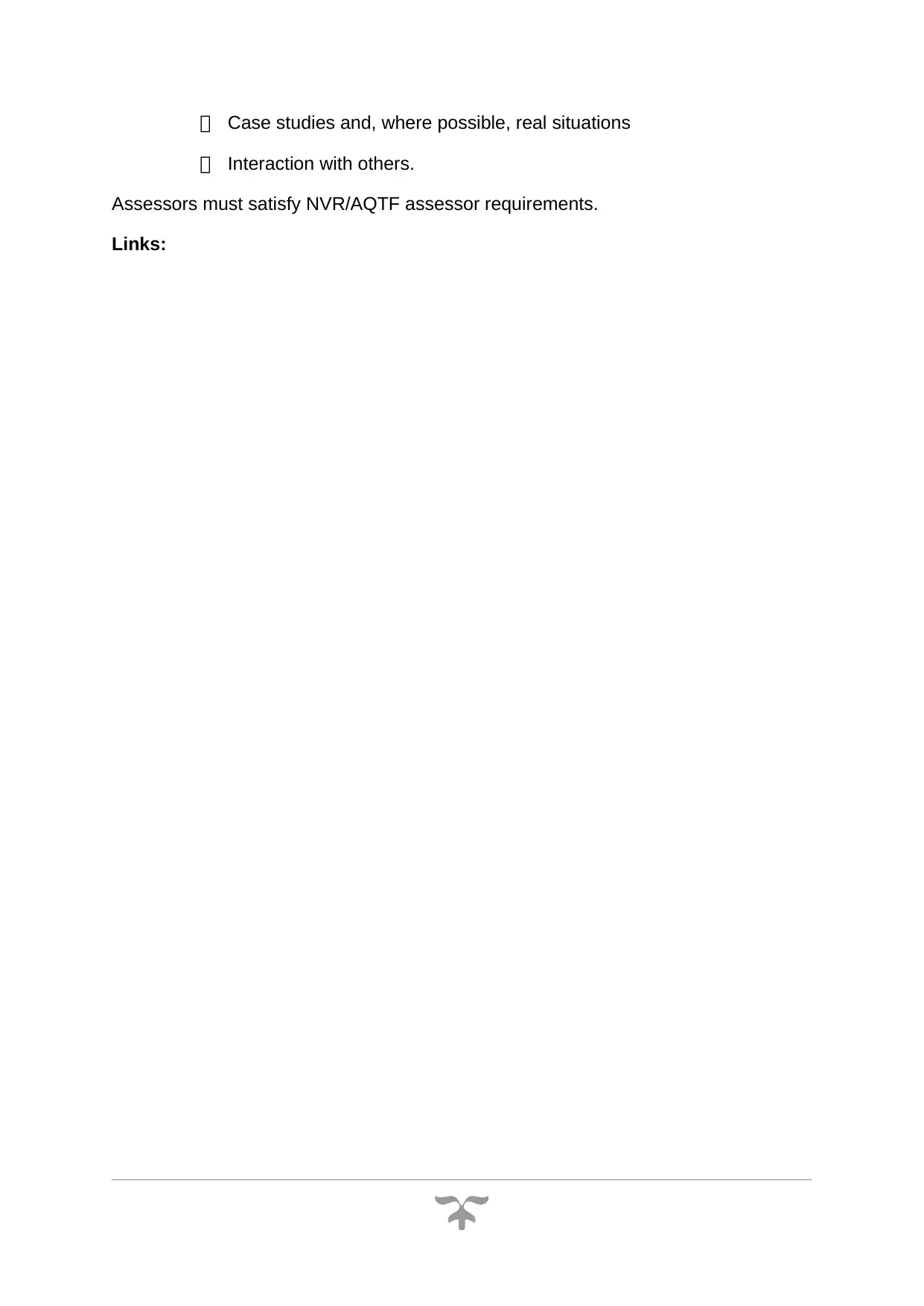
Case studies and, where possible, real situations
Interaction with others.
Assessors must satisfy NVR/AQTF assessor requirements.
Links:
Interaction with others.
Assessors must satisfy NVR/AQTF assessor requirements.
Links:
⊘ This is a preview!⊘
Do you want full access?
Subscribe today to unlock all pages.

Trusted by 1+ million students worldwide
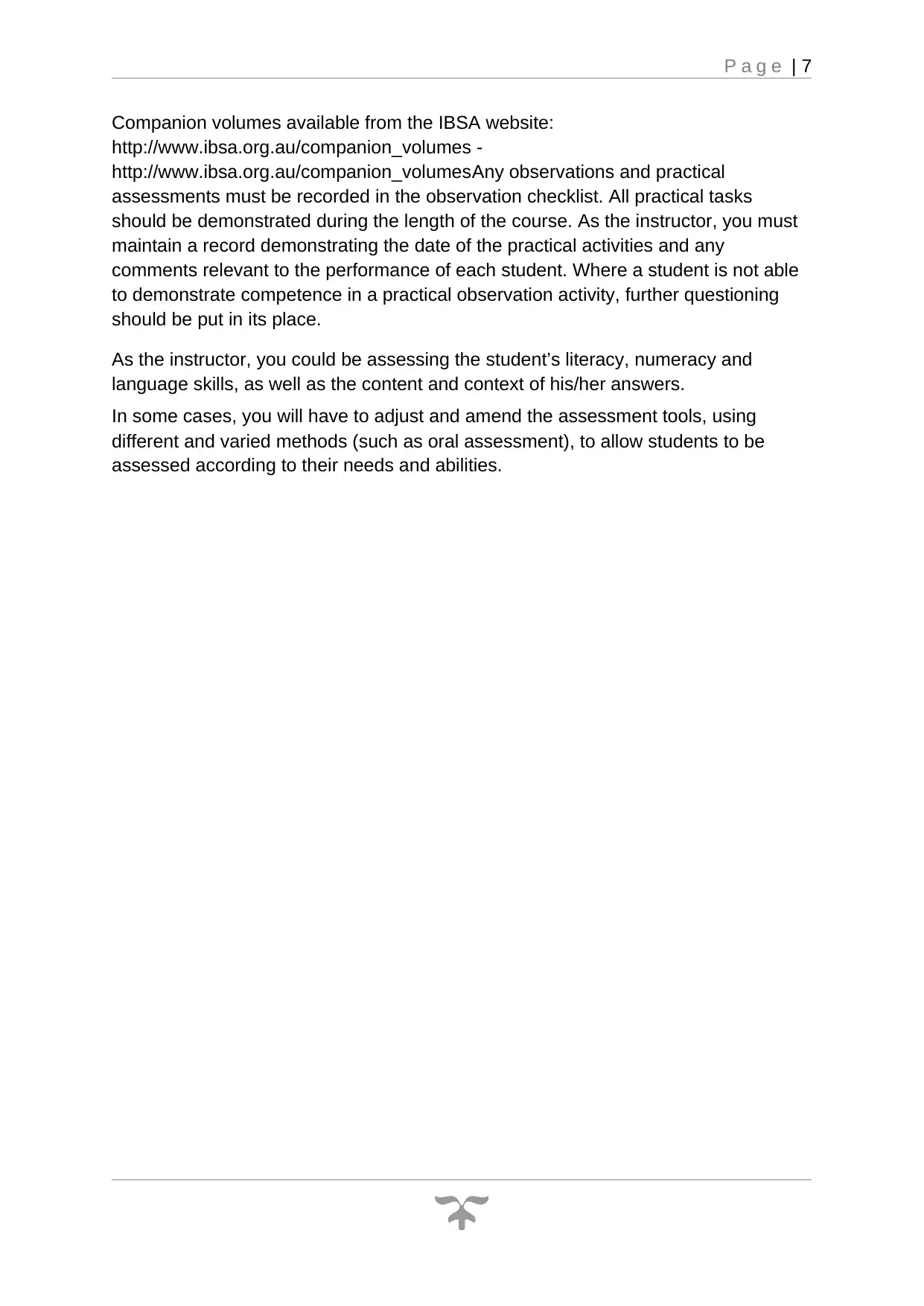
P a g e | 7
Companion volumes available from the IBSA website:
http://www.ibsa.org.au/companion_volumes -
http://www.ibsa.org.au/companion_volumesAny observations and practical
assessments must be recorded in the observation checklist. All practical tasks
should be demonstrated during the length of the course. As the instructor, you must
maintain a record demonstrating the date of the practical activities and any
comments relevant to the performance of each student. Where a student is not able
to demonstrate competence in a practical observation activity, further questioning
should be put in its place.
As the instructor, you could be assessing the student’s literacy, numeracy and
language skills, as well as the content and context of his/her answers.
In some cases, you will have to adjust and amend the assessment tools, using
different and varied methods (such as oral assessment), to allow students to be
assessed according to their needs and abilities.
Companion volumes available from the IBSA website:
http://www.ibsa.org.au/companion_volumes -
http://www.ibsa.org.au/companion_volumesAny observations and practical
assessments must be recorded in the observation checklist. All practical tasks
should be demonstrated during the length of the course. As the instructor, you must
maintain a record demonstrating the date of the practical activities and any
comments relevant to the performance of each student. Where a student is not able
to demonstrate competence in a practical observation activity, further questioning
should be put in its place.
As the instructor, you could be assessing the student’s literacy, numeracy and
language skills, as well as the content and context of his/her answers.
In some cases, you will have to adjust and amend the assessment tools, using
different and varied methods (such as oral assessment), to allow students to be
assessed according to their needs and abilities.
Paraphrase This Document
Need a fresh take? Get an instant paraphrase of this document with our AI Paraphraser

Assessment Tool Definitions
Assessment Tool How is it used? What is it?
Learner Workbook Activities
(Entire completion is required)
Each student should be given a Learner Workbook
which will hold several activities, both formative and
summative, that all need to be completed in
conjunction with the appropriate sessions. The
PowerPoint, Learner Guide and instructor should
provide further information to help with the activities.
Observation/Demonstration
(To be completed for each numbered
point as stated on the checklist)
An observation should be completed for each of the
students by the instructor. If the tasks aren’t
everyday actions, a simulated environment is
acceptable, or a demonstration can be set up. An
observation checklist can be found at the end of this
document.
Major Activity
(Entire completion is required)
A Major Activity is a summative assessment and can
be found in the Learner Workbook, after all the
activities are completed. This is an extended piece of
summative assessment which should take anywhere
between 1-2 hours and every student should
complete this work. It is a requirement for each unit
to check knowledge and understanding.
Skills and Knowledge Activity
(Entire completion is required)
A Skills and Knowledge Activity is a summative
assessment and is found before the Major Activity in
the Learner Workbook. This should take between 1-2
hours and every student should complete this work.
It is a requirement for each unit to check knowledge
and understanding of the foundation skills and
knowledge evidence.
Case Study
(Entire completion is required)
Not all units will have Case Studies but those that do
will be clearly stated within the PowerPoint and the
Learner Workbook. It will appear as any other
activity, but it will be named ‘Case Study’ and will
provide an example of a possible real-life situation
for the learner to read, interpret and then answer
questions on.
Learner Guide
(To be used as an informational guide)
The Learner Guide links with the Learner Workbook
as it provides the information given during sessions
and more. It can help students to further their
knowledge and to also complete the activities.
Evidence Document
(Not a necessity for completion of unit
but can be used as an aid or to collect
further evidence)
The Evidence Document lists all the Elements and
Performance Criteria with an area for written reports
etc, to add evidence to the student’s portfolio. It can
be used for any of the performance criteria,
especially those which may not have been covered
by any other assessment tool. The student can circle
several the criteria that they may feel they need
further evidence of, or it can be used as a guide for
completing further Observations and Third-Party
reports.
Assessment Tool How is it used? What is it?
Learner Workbook Activities
(Entire completion is required)
Each student should be given a Learner Workbook
which will hold several activities, both formative and
summative, that all need to be completed in
conjunction with the appropriate sessions. The
PowerPoint, Learner Guide and instructor should
provide further information to help with the activities.
Observation/Demonstration
(To be completed for each numbered
point as stated on the checklist)
An observation should be completed for each of the
students by the instructor. If the tasks aren’t
everyday actions, a simulated environment is
acceptable, or a demonstration can be set up. An
observation checklist can be found at the end of this
document.
Major Activity
(Entire completion is required)
A Major Activity is a summative assessment and can
be found in the Learner Workbook, after all the
activities are completed. This is an extended piece of
summative assessment which should take anywhere
between 1-2 hours and every student should
complete this work. It is a requirement for each unit
to check knowledge and understanding.
Skills and Knowledge Activity
(Entire completion is required)
A Skills and Knowledge Activity is a summative
assessment and is found before the Major Activity in
the Learner Workbook. This should take between 1-2
hours and every student should complete this work.
It is a requirement for each unit to check knowledge
and understanding of the foundation skills and
knowledge evidence.
Case Study
(Entire completion is required)
Not all units will have Case Studies but those that do
will be clearly stated within the PowerPoint and the
Learner Workbook. It will appear as any other
activity, but it will be named ‘Case Study’ and will
provide an example of a possible real-life situation
for the learner to read, interpret and then answer
questions on.
Learner Guide
(To be used as an informational guide)
The Learner Guide links with the Learner Workbook
as it provides the information given during sessions
and more. It can help students to further their
knowledge and to also complete the activities.
Evidence Document
(Not a necessity for completion of unit
but can be used as an aid or to collect
further evidence)
The Evidence Document lists all the Elements and
Performance Criteria with an area for written reports
etc, to add evidence to the student’s portfolio. It can
be used for any of the performance criteria,
especially those which may not have been covered
by any other assessment tool. The student can circle
several the criteria that they may feel they need
further evidence of, or it can be used as a guide for
completing further Observations and Third-Party
reports.

P a g e | 9
Observation/Demonstration
Throughout this unit, the learner will be expected to show their competency of the
elements through observations or demonstrations. The observations and
demonstrations will be completed as well as the formative and summative
assessments found in the Learner Workbook. An explanation of demonstrations and
observations:
Demonstration is off-the-job
A demonstration will require:
Performing a skill or task that is asked of you
Undertaking a simulation exercise
Observation is on-the-job
The observation will usually require:
Performing a work-based skill or task
Interaction with colleagues and/or customers
The observation/demonstration will take place either in the workplace or the training
environment, depending on the task to be undertaken and whether it is an
observation or demonstration. Each task must be observed. You will need to ensure
you provide the learner with the correct equipment and/or materials to complete the
task. You will also need to inform the learner of the time they have to complete the
task; this will once again vary, depending on the task.
Learner should be able to demonstrate they can:
1. Develop employee and industrial relations policies and plans
2. Implement employee relations policies and plans
3. Manage negotiations to resolve conflict.
Learners should also demonstrate the following skills:
Reading
Writing
Oral communication
Numeracy
Navigate the world of work
Interact with others
Observation/Demonstration
Throughout this unit, the learner will be expected to show their competency of the
elements through observations or demonstrations. The observations and
demonstrations will be completed as well as the formative and summative
assessments found in the Learner Workbook. An explanation of demonstrations and
observations:
Demonstration is off-the-job
A demonstration will require:
Performing a skill or task that is asked of you
Undertaking a simulation exercise
Observation is on-the-job
The observation will usually require:
Performing a work-based skill or task
Interaction with colleagues and/or customers
The observation/demonstration will take place either in the workplace or the training
environment, depending on the task to be undertaken and whether it is an
observation or demonstration. Each task must be observed. You will need to ensure
you provide the learner with the correct equipment and/or materials to complete the
task. You will also need to inform the learner of the time they have to complete the
task; this will once again vary, depending on the task.
Learner should be able to demonstrate they can:
1. Develop employee and industrial relations policies and plans
2. Implement employee relations policies and plans
3. Manage negotiations to resolve conflict.
Learners should also demonstrate the following skills:
Reading
Writing
Oral communication
Numeracy
Navigate the world of work
Interact with others
⊘ This is a preview!⊘
Do you want full access?
Subscribe today to unlock all pages.

Trusted by 1+ million students worldwide

Get the work done
Paraphrase This Document
Need a fresh take? Get an instant paraphrase of this document with our AI Paraphraser
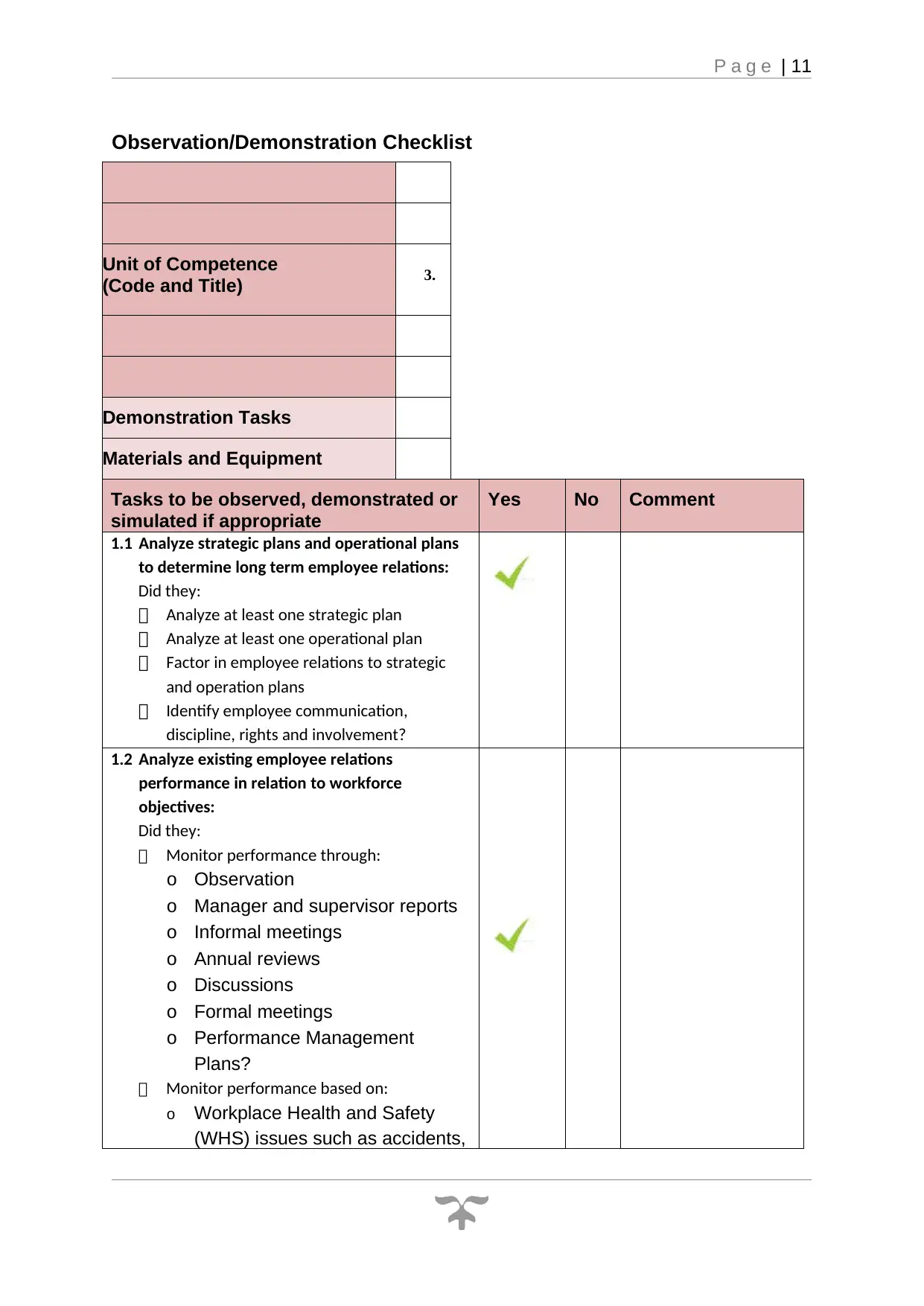
P a g e | 11
Observation/Demonstration Checklist
Unit of Competence
(Code and Title) 3.
Demonstration Tasks
Materials and Equipment
Tasks to be observed, demonstrated or
simulated if appropriate
Yes No Comment
1.1 Analyze strategic plans and operational plans
to determine long term employee relations:
Did they:
Analyze at least one strategic plan
Analyze at least one operational plan
Factor in employee relations to strategic
and operation plans
Identify employee communication,
discipline, rights and involvement?
1.2 Analyze existing employee relations
performance in relation to workforce
objectives:
Did they:
Monitor performance through:
o Observation
o Manager and supervisor reports
o Informal meetings
o Annual reviews
o Discussions
o Formal meetings
o Performance Management
Plans?
Monitor performance based on:
o Workplace Health and Safety
(WHS) issues such as accidents,
Observation/Demonstration Checklist
Unit of Competence
(Code and Title) 3.
Demonstration Tasks
Materials and Equipment
Tasks to be observed, demonstrated or
simulated if appropriate
Yes No Comment
1.1 Analyze strategic plans and operational plans
to determine long term employee relations:
Did they:
Analyze at least one strategic plan
Analyze at least one operational plan
Factor in employee relations to strategic
and operation plans
Identify employee communication,
discipline, rights and involvement?
1.2 Analyze existing employee relations
performance in relation to workforce
objectives:
Did they:
Monitor performance through:
o Observation
o Manager and supervisor reports
o Informal meetings
o Annual reviews
o Discussions
o Formal meetings
o Performance Management
Plans?
Monitor performance based on:
o Workplace Health and Safety
(WHS) issues such as accidents,

incidents and near misses
o Absenteeism and sickness
o Lateness
o Productivity
o Staff turnover
o Performance appraisals and
reviews
o Staff training and development
o Staff satisfaction based on
surveys and feedback
o Complaints and grievances?
1.3 Evaluate options in terms of cost-benefit, risk-
analysis and current legislative requirements
policies and plans:
Did they:
Evaluate cost benefit, through:
Productivity
Employee loyalty
Quality
Fair pay?
Conduct risk management in the workplace, by
evaluating:
Likelihood
Consequence?
Evaluate options against:
Fair Work act
National Employment Standards
WHS and environmental issues
Codes of practice
Anti-discrimination?
1.4 Work with the management team to develop
industrial relations policies and plans:
Did they:
Consider site, enterprise and statutory
requirements, including:
Award and enterprise agreements,
and relevant industrial instruments?
Dispute settlement procedures?
Grievance mechanisms?
Relevant industry codes of practice
WHS and environmental issues
Equal opportunity
o Absenteeism and sickness
o Lateness
o Productivity
o Staff turnover
o Performance appraisals and
reviews
o Staff training and development
o Staff satisfaction based on
surveys and feedback
o Complaints and grievances?
1.3 Evaluate options in terms of cost-benefit, risk-
analysis and current legislative requirements
policies and plans:
Did they:
Evaluate cost benefit, through:
Productivity
Employee loyalty
Quality
Fair pay?
Conduct risk management in the workplace, by
evaluating:
Likelihood
Consequence?
Evaluate options against:
Fair Work act
National Employment Standards
WHS and environmental issues
Codes of practice
Anti-discrimination?
1.4 Work with the management team to develop
industrial relations policies and plans:
Did they:
Consider site, enterprise and statutory
requirements, including:
Award and enterprise agreements,
and relevant industrial instruments?
Dispute settlement procedures?
Grievance mechanisms?
Relevant industry codes of practice
WHS and environmental issues
Equal opportunity
⊘ This is a preview!⊘
Do you want full access?
Subscribe today to unlock all pages.

Trusted by 1+ million students worldwide
1 out of 53
Related Documents
Your All-in-One AI-Powered Toolkit for Academic Success.
+13062052269
info@desklib.com
Available 24*7 on WhatsApp / Email
![[object Object]](/_next/static/media/star-bottom.7253800d.svg)
Unlock your academic potential
Copyright © 2020–2025 A2Z Services. All Rights Reserved. Developed and managed by ZUCOL.





